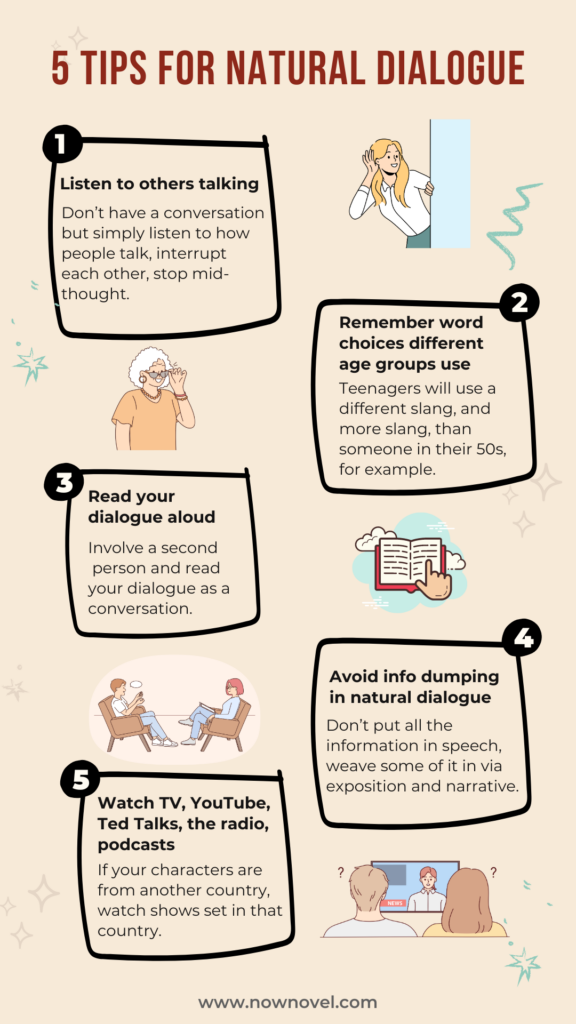Whether you’re writing a novel or a short story, you are going to want to make your dialogue natural and true to real life, as it’s spoken in the real world. How do you go about achieving this, when ‘natural dialogue’ can be boring to read if you write it verbatim?
As to why you should make your dialogue sound natural, Daniel Boyko and Zoha Arif of Polyphonic Lit have this to say:
Unnatural, inorganic dialogue can make any character sound like an evil robotic Martian stranded on the great abomination of earth (with no hope of reconnecting with its extraterrestrial kind), trying to camouflage into human society and failing completely and utterly to do so.
We’re going to look into some ways of rendering your fictional dialogue as true to life as possible, without boring your readers. And without them sounding like evil robotic Martians.
Real speech vs fictional dialogue
In his book How to Write Dazzling Dialogue, James Scott Bell explains the difference between real speech and fictional dialogue. He writes that:
Dialogue is not real-life speech. It is stylized speech for which the author, through the characters, has a purpose.
That’s a crucial distinction. We don’t want to merely capture reality in our fiction. We aren’t filming a documentary.
What we do is render something that feels real but is intended to create a desired effect.
Real-life speech is meandering and often boring.
Fictional speech doesn’t meander (unless, of course, a character has a strong reason to run on and on).
Firstly, you have to listen to natural dialogue. The best way of doing this is not to have a conversation, because then you are so busy being part of the give and take that you don’t really hear the natural rhythms of dialogue. One recommendation is to go to a coffee shop and eavesdrop. Listen to how people speak in the real world, note the rhythms and cadences: when people get excited, or sad, note how the tone changes. Note, too, how people don’t use complete sentences, how people pause, and sometimes the listener will rush in to fill that gap while the speaker is pausing. Notice when people lose their place, forget things, and just simply don’t complete their thoughts. And yet despite that, the meaning of what they are saying is implied by the rest of the sentence.
Word choices
Listen to word choices: a group of teenagers will use different word choices to someone in their thirties or forties or someone in their sixties. Pay close attention to the slang that teens use. Similarly, listen to people in their sixties or seventies. They too are using slang, but it will be the slang of their generation. Or they might be using different terms for things. Here’s an example: my eightysomething mother uses the word ‘rouge’ to mean ‘blusher’ and ‘base’ to mean ‘foundation’. I know both terms as I grew up hearing her use these terms. But I use blusher and foundation. My mother refers to countries and ships as ‘she’: that sounds so odd to me.
So when you are writing, take note of the ages of your characters. Weave these differences into your writing. Have an older person refer to a ship as a she. Have a teen or younger person say it’s ‘super cool’. Have an older person say ‘super duper’. All these differences will alert your reader to the fact that these are different characters.
The absolute worst thing is to have your characters sound the same—and this is one way of avoiding this common trap. Each character must speak in their own voice, whatever that voice is. Bell keeps a ‘voice journal’ to avoid them sounding the same. Bell describes it:
One of my favorite exercises when planning a novel is the Voice Journal. This is a free-form document, stream of consciousness, in the character’s own voice. How do I know what the character’s voice sounds like? I prompt them with questions and then let them talk. I do this fast, without thinking about it much. What I’m waiting for is the moment when the character starts talking to me in a voice I did not plan.
And it always happens. That’s the fun part, when the character starts to take on life for me.
We don’t want our characters sounding the same when they speak, and the Voice Journal helps you avoid that condition.
Read your dialogue aloud – dialogue is, after all, meant to replicate real speech. Record yourself doing so. Better yet rope in a friend, family member or anyone who is enthusiastic, and get them to read with you, with each of you taking different parts.
Tweet This
Buy a course on dialogue
Learn how to format dialogue, how to use dialogue to illustrate characters, subtext and context and more.

Read dialogue aloud
Read your dialogue aloud – dialogue is, after all, meant to replicate real speech. Record yourself doing so. Better yet rope in a friend, family member or anyone who is enthusiastic, and get them to read with you, with each of you taking different parts. This will also show you if your characters are sounding too alike.
And, refrain from your characters calling each other by their names all the time. This is something we rarely do in real life. We sometimes do so for emphasis, or when we are introducing a friend to another, for example.
There are also natural ‘ticks’ that people use in their speech. Someone might end many sentences with ‘you know’, or ‘hey?’ Some British people end their sentences with ‘isn’t it’. Sprinkle these through your dialogue to make it natural—just don’t use them all the time, or this will become annoying to read.
Another interesting thing to note is that people often omit the ‘I’ at the beginning of sentences. Again, that is implied. For example, someone might say, ‘Wish it would rain’ and the listener knows that the speaker means, ‘I wish it would rain.’ All this will make your dialogue as natural as possible to resemble the real world.
Avoid ‘ad speak’ or ‘info dump’
Another way to make dialogue sound natural is to avoid using it as a way to convey too much information about your backstory or some other part of your story. This can also be referred to as ‘ad speak’ or an ‘info dump’. That’s when a character in an advert is going on about a particular product, saying it’s 100% concentrated to remove stains and what’s more, you now get 20% more in each bottle. That’s not how people really speak. Similarly, we would hardly say to a friend, ‘You know, my mom, who was born in Ireland, in 1952, and met my father in 1975, and then had me in 1978 and my sister in 1981 …’ You get the picture. Your friend probably knows your mother is Irish, for example. If you want to convey all this information, you should try and weave it into the natural exposition of your story.
David Baldacci addresses this:
Avoid info dumping. Beginning writers tend to drop large chunks of information onto the page all at once. This is called info dumping, and not only does it bore readers, but it stops the momentum cold. You want to make your information feel natural and interesting. You can avoid the dreaded info dump by having your characters discover information in the course of a conversation. If that feels overly expository, let them discover information via action.
Consider body language
Look at body language too. Our body language forms part of our way of communicating, and this is another trick to make your writing pop when you’re writing dialogue. One character might nervously run a small scar on their face when they are under pressure. Another might have glasses that keep slipping down their face, and they push them up abruptly. Punctuate the speech with these tics: this will also help to distinguish your characters from each other and make each stand out in unique ways. Again, when you are eavesdropping, take a note of these gestures, the body language of people: hunched shoulders, frowns, grand gestures that knock glasses of water over. These are all incredibly useful to include in dialogue.

Edit the speech
Remember that you need to make your dialogue natural, but you to also ‘edit’ it. In real life we use umms and ahhs and repeat things, and this would be boring to read. Similarly, although in the real world we use small talk, to read this is boring. For example, have a look at this exchange:
“Hello, Paul!”
“Hello, Nadira.”
“It’s hot today.”
“It is.”
“Wish it would rain.”
“Hmm…”
“We need the rain…”
“Uh huh..”
Gosh that’s boring to read! Unless this exchange is somehow advancing the plot, like rain in this story is a metaphor for something else, like gangsters or something and we know this as readers, and so we are in on that secret.
But have a look at the uh huh, hmms—they don’t make for riveting reading.
So, unless this exchange will advance the plot, don’t use small talk in your fiction, or keep it to a bare minimum.
And, another pointer: use contractions! This is the way people talk in real life, so unless you have a character set in the past, or who is extremely formal, make full use of them.
Work with a coach
Developing a story takes time and commitment.
Sign up to work with a coach for a helping hand along the way.
Read dialogue in books
Another tip to rendering natural dialogue is to read a range of books. Read fiction set in contemporary times (if that’s where your story is set). See how other writers have done it. If you’re American and you have a British character who lives in London, make sure that you are using speech that is different to the way an American would use it. Here’s an example:
American person: “Did you eat yet?”
English person: “Have you eaten yet?”
Interesting changes! And don’t forget the occasional “isn’t it” refrains for your London-based character. There are also many ways to render dialects and accents, have a read of this list of six tips.
Watch movies and TV shows. Try and get transcripts to see how they render natural dialogue. And again, if you’re writing a character not from your culture or country, see how they speak from these visual mediums. Watch Ted talks too! Listen to the radio, too.
- For more ways and tips to creating great dialogue have a look at context and subtext in dialogue. Also have a read of how to make dialogue carry your story.



